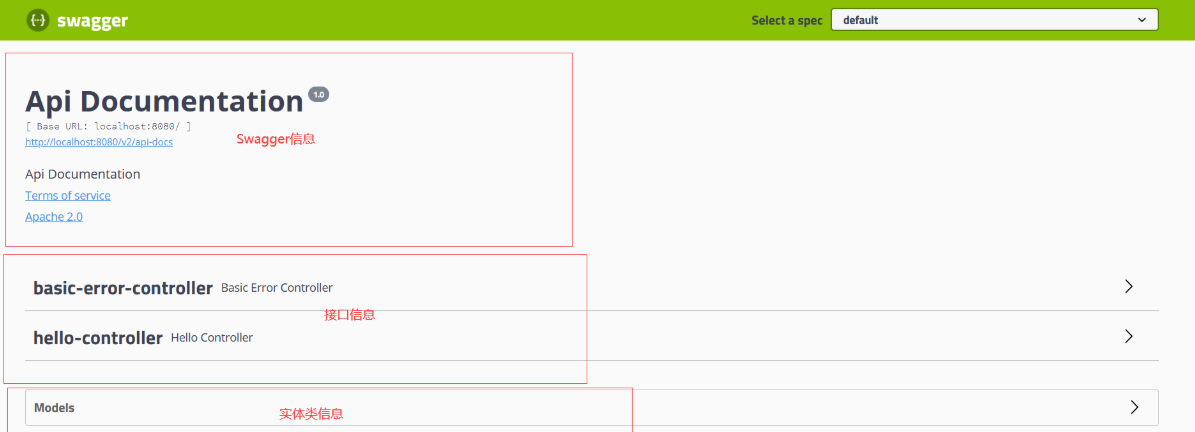Swagger入门
前后端分离
Vue+SpringBoot
前后端分离时代
-
后端:后端控制层,服务层,数据访问层
-
前端:前端控制层,视图层
-
伪造后端数据,json。已经存在了,不需要后端的数据
-
-
前后端如何交互? API
-
前后端相对独立,松耦合
-
前后端甚至可以部署在不同的服务器上
产生一个问题:
-
前后端集成联调。前端人员和后端人员无法做到,及时协商,尽早解决,最终导致问题集中爆发
解决方案:
-
首先指定schema,实时更新最新API,降低集成的风险
-
早些年:制定word计划文档;
-
前后端分离:
-
前端测试后端接口:postman
-
后端提供接口,需要实时最新的消息及改动
-
Swagger
-
号称世界上最流行的Api框架
-
RestFul Api 文档在线自动生成工具 Api与API定义同步更新
-
直接运行,可以在线测试API接口
-
只是多种语言(Java,Php。。)
在项目中使用Swagger,需要springbox;
-
swagger2
-
ui
SpringBoot集成Swagger
1.新建一个SpringBoot-web项目
2.导入相关依赖
<dependency>
<groupId>io.springfox</groupId>
<artifactId>springfox-swagger2</artifactId>
<version>2.9.2</version>
</dependency>
<dependency>
<groupId>io.springfox</groupId>
<artifactId>springfox-swagger-ui</artifactId>
<version>2.9.2</version>
</dependency>
3.编写helloworld工程
4.配置Swagger Config
5.测试运行
http://localhost:8080/swagger-ui.html

peizhiSwagger
Swagger的bean实例Docket;
package com.zhou.swagger.config;
import org.springframework.context.annotation.Bean;
import org.springframework.context.annotation.Configuration;
import springfox.documentation.service.ApiInfo;
import springfox.documentation.service.Contact;
import springfox.documentation.spi.DocumentationType;
import springfox.documentation.spring.web.plugins.Docket;
import springfox.documentation.swagger2.annotations.EnableSwagger2;
import java.util.ArrayList;
import static springfox.documentation.service.ApiInfo.DEFAULT_CONTACT;
Swagger配置扫描接口
Docket.select()
public Docket docket(){
return new Docket(DocumentationType.SWAGGER_2)
.apiInfo(apiInfo())
.select()
//requestHandlerSelectors,配置要扫描接口的方式
//basePackage,指定要扫描的包
//any() 扫描全部
//none() 不扫描
//withClassAnnotation 扫描类上的注解
//withMethodAnnotation 扫描方法上的注解
.apis(RequestHandlerSelectors.basePackage("com.zhou.swagger.controller"))
//选择路径,过滤
.paths(PathSelectors.ant("/zhou/**"))
.build();
}
配置是否启动
//配置了Swagger的Docket实例
//enable是否启动Swagger,false则swagger不能在浏览器中访问
我只希望我的swagger在生产环境中使用,在发布的时候不使用
public Docket docket(Environment environment){
//设置要显示的swagger环境
Profiles profiles= Profiles.of("dev", "test");
//获取项目的环境,判断是否处于自己设定的环境中
boolean flag=environment.acceptsProfiles(profiles);
return new Docket(DocumentationType.SWAGGER_2)
.apiInfo(apiInfo())
.enable(flag)
配置API分组
.groupName("kokokp")
如何配置多个组;多个Docket实例
实体类配置
@RestController
public class HelloController {
@GetMapping(value = "/hello")
public String hello(){
return "hello";
}
//只要我们的接口中,返回值中存在实体类,它就会被扫描到Swagger中
@PostMapping(value = "/user")
public User user(){
return new User();
}
}
//@Api(注释)
@ApiModel("用户实体类")
public class User {
@ApiModelProperty("用户名")
public String username;
@ApiModelProperty("用户密码")
public String password;
}
总结:
-
我们可以通过Swagger给一些比较难理解的属性或者接口,增加注释信息
-
接口文档实时更新
-
可以在线测试
Swagger是一个优秀的工具
注意点
在正式发布的时候,关闭Swagger!!!出于安全考虑,而且节省运行内存。



 浙公网安备 33010602011771号
浙公网安备 33010602011771号